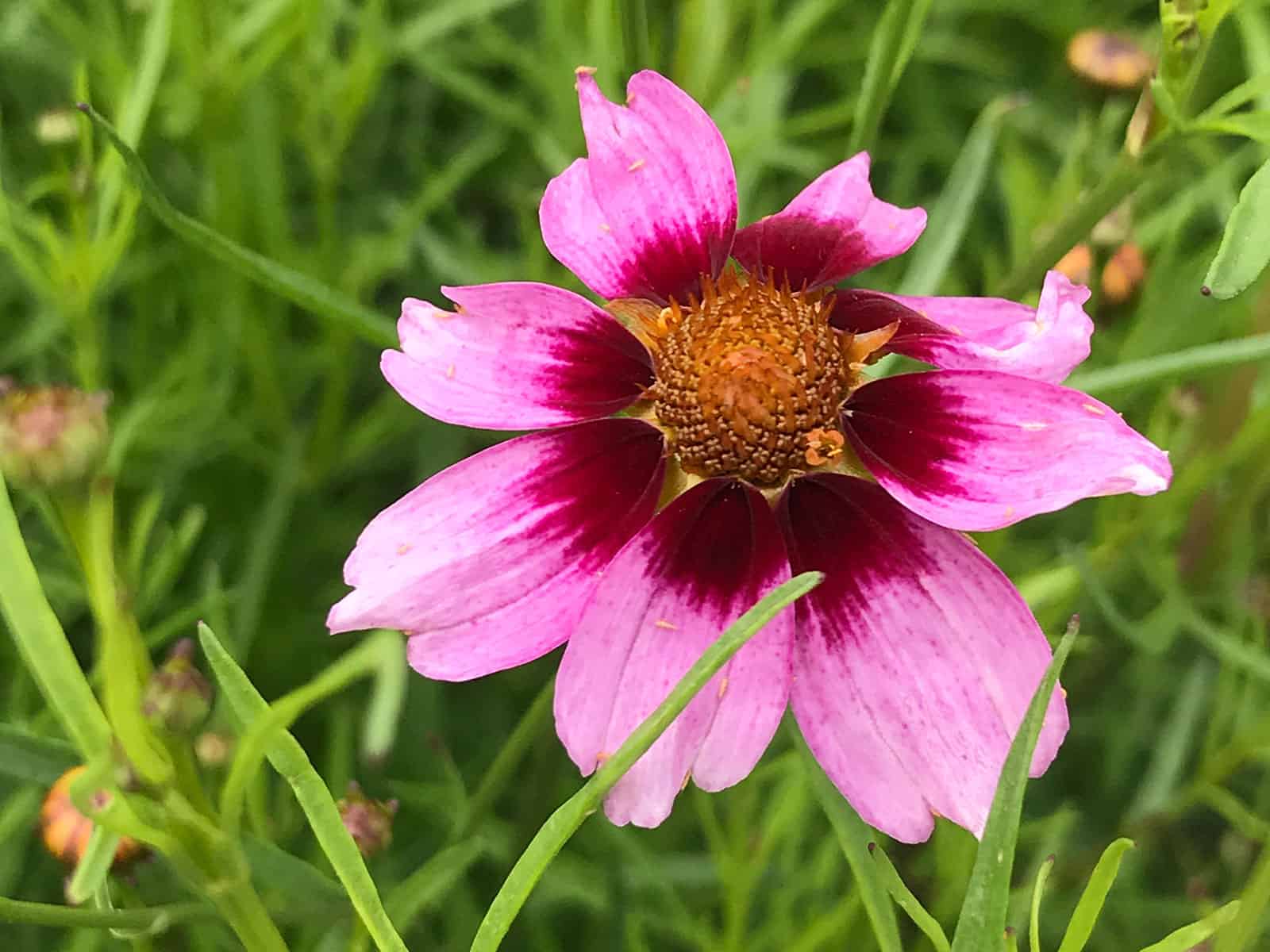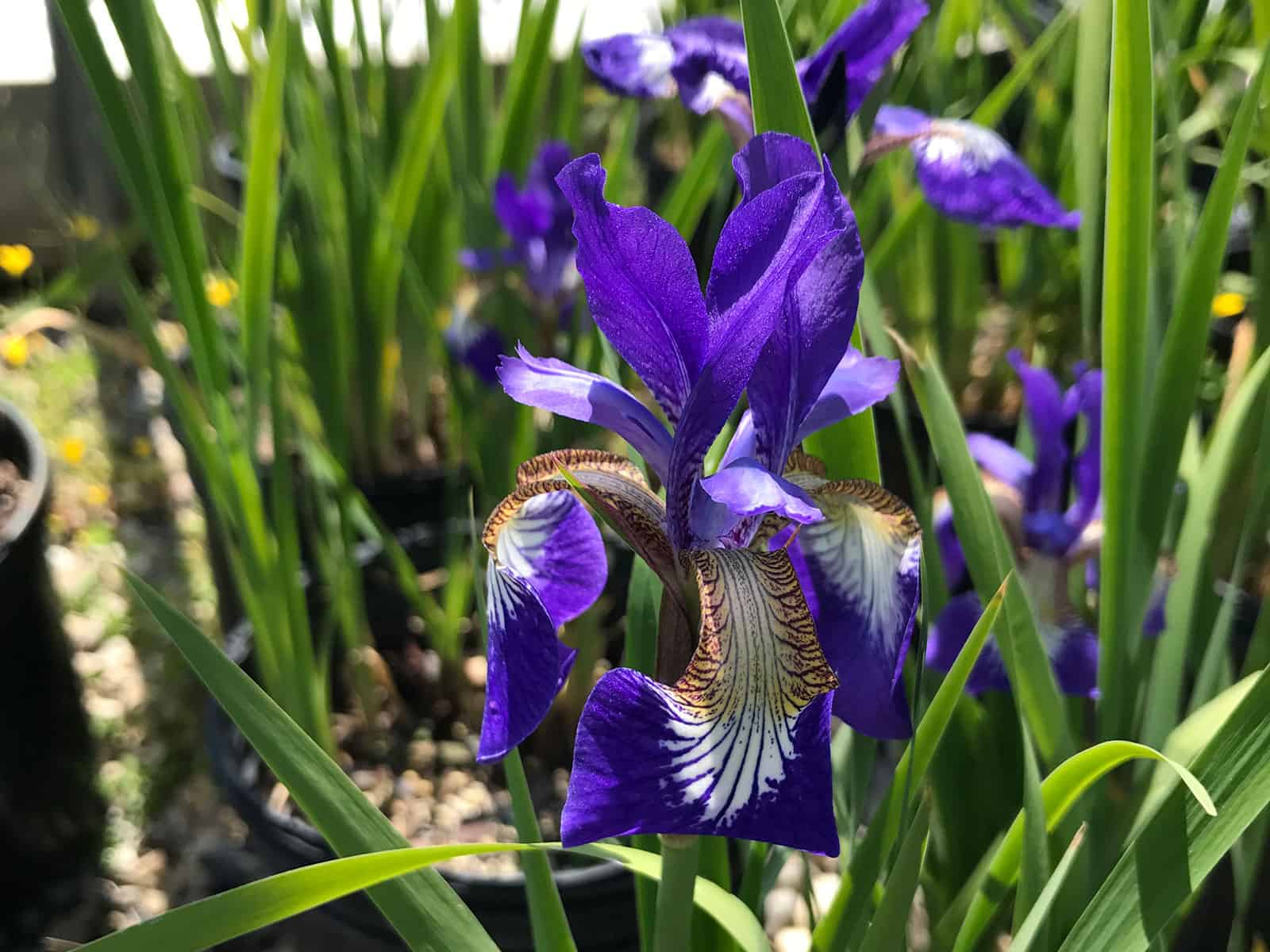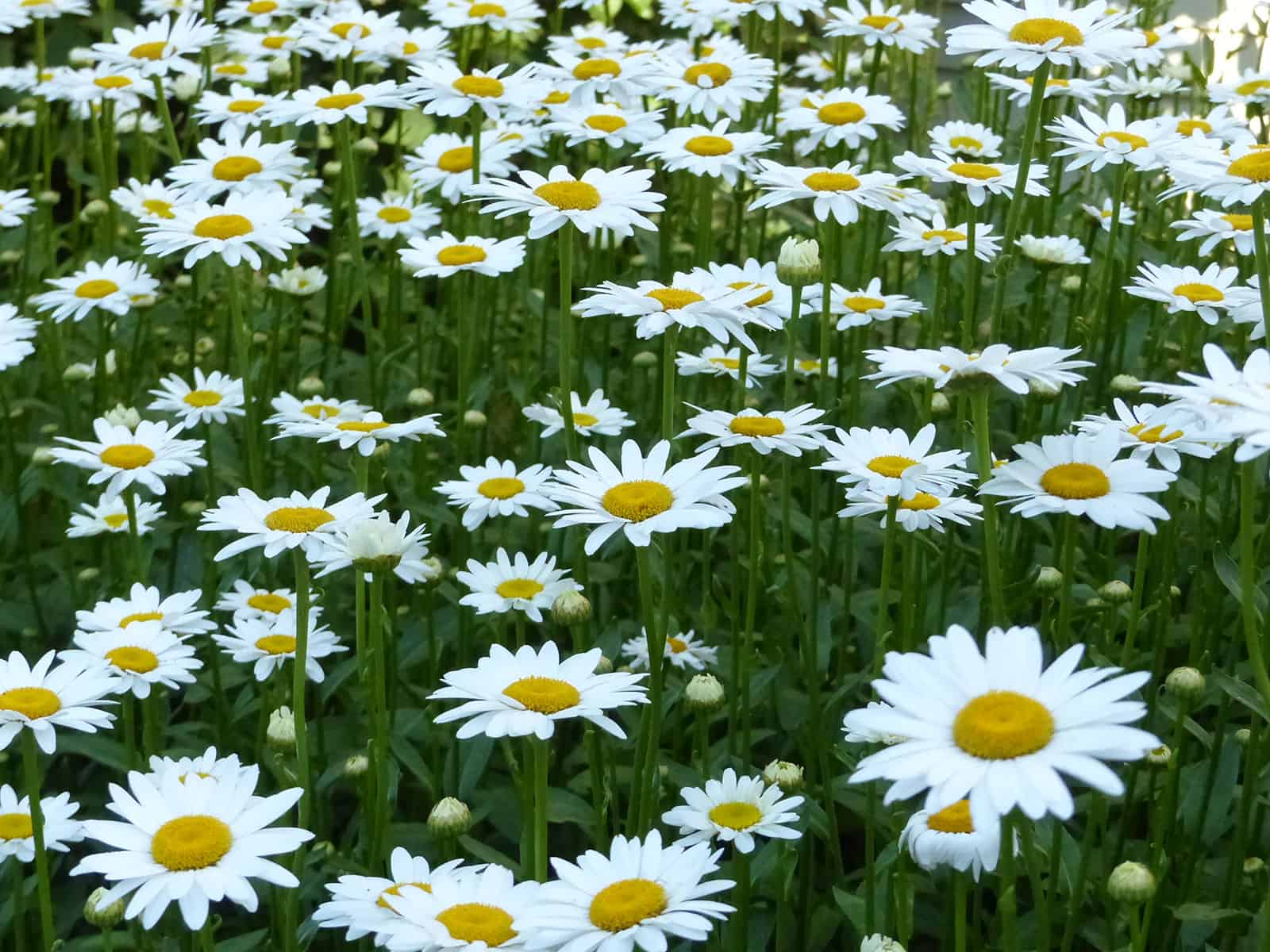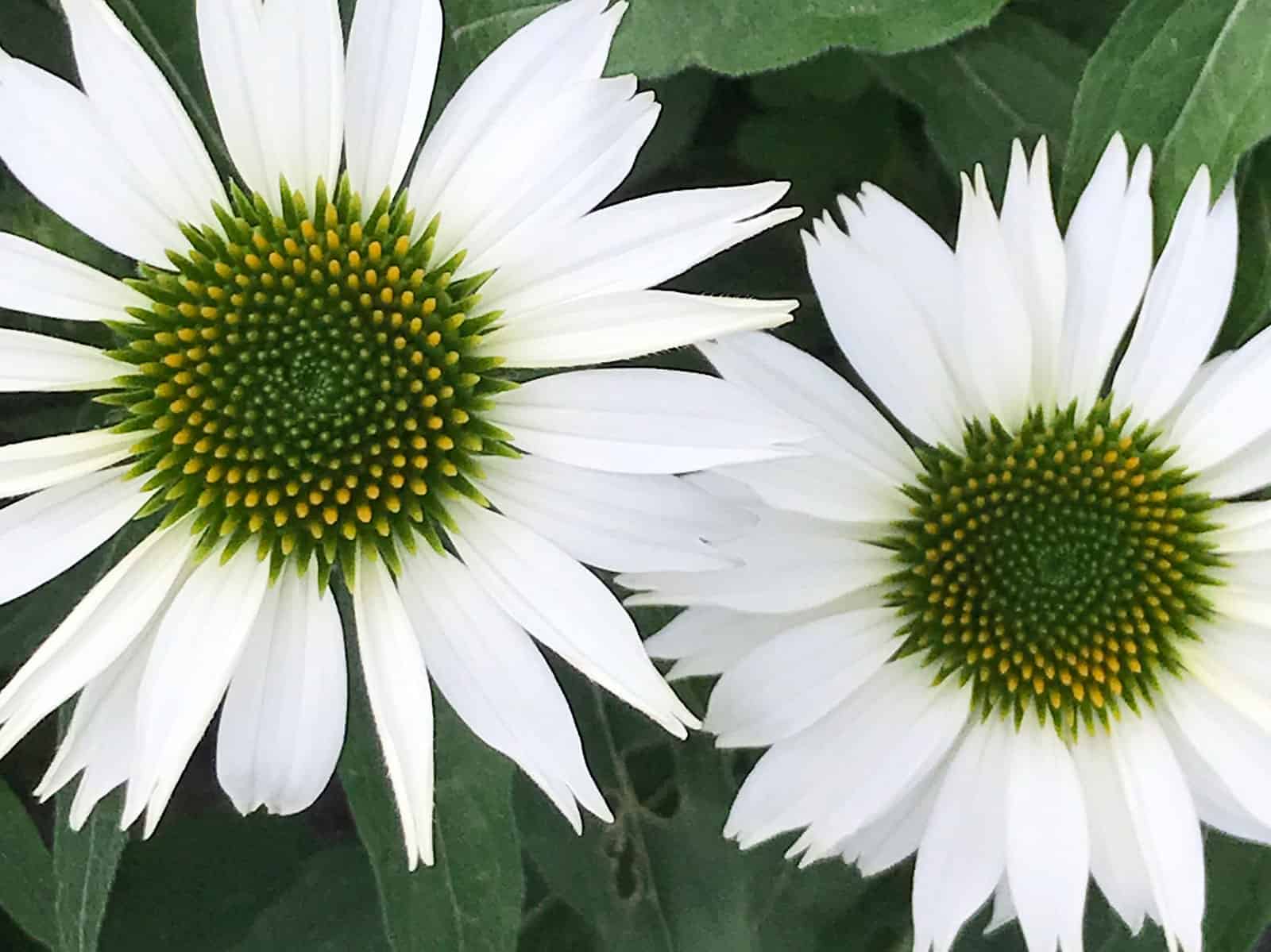A cousin to the familiar Lamb’s-Ears, but not at all similar. This is a clump-forming perennial, forming a low mound of green foliage that remains attractive all season long. In early summer the upright spikes of ‘cotton candy’ pink flowers appear attracting bees to the nectar. Removing faded flowers will encourage more buds to form for weeks on end. An interesting and unusual perennial for near the front of the border, or in containers. Plants may be clipped back hard immediately after blooming, to tidy up the clumps for the rest of the season. Easily divided in early spring. Bred by Richard Hawke and introduced to the market by Chicago Botanic Garden. USPP#21436: unlicensed propagation prohibited.
An improved selection of the Coreopsis ‘Rosea’. This forms a low, bushy mound of ferny green foliage, bearing masses of pink to rose colored daisy like flowers. Flowering begins in early summer and continues for weeks.
The Siberian Iris Caesar’s Brother iris produces deep purple flowers in late spring with sturdy stems which rise to 40″ high above a clump of grass-like, linear leaves. The delicate leaves make them one of the queens of fresh cut floral bouquets. After blooming is complete, the vase-shaped foliage will retain its green color into the fall. Symbolizes: eloquence, deep sentiment, faith hope & wisdom. February birth month flower. 25th Wedding Anniversary flower.

Easily grown in average, dry to medium, well-drained soils in full sun. Good soil drainage is essential. Wet soils in winter can be fatal. Tolerates some light shade, particularly in hot summer climates or when plants are being grown in dryish soils. Remove spent flower heads to promote additional bloom. Divide clumps as needed (every 2-3 years) to maintain vigor. Plants are somewhat short-lived. Consider cutting stems back to basal leaves after flowering to preserve plant energies and perhaps prolong plant life.
Noteworthy Characteristics: Leucanthemum x superbum, commonly called Shasta daisy, is a hybrid developed by Luther Burbank (1849-1926) in the 1890s near snow covered Mt. Shasta in northern California. Burbank crossed Leucanthemum vulgare (European oxeye daisy), Leucanthemum maximum (Pyrenees chrysanthemum), Leucanthemum lacustre (Portuguese field daisy) and Nipponanthemum nipponicum (Japanese field daisy) to produce Leucanthemum x superbum which was given the common name of Shasta daisy. This hybrid typically grows to 2-3′ tall with a spread to 18″ wide.
Leucanthemums were formerly included in the genus Chrysanthemum.
Genus name comes from the Greek leukos meaning white and anthemum meaning flower in reference to the white flowers of some species.
Specific epithet means superb.
‘Becky’ is larger than most other Shasta cultivars, growing 3-4′ tall on rigid stems which do not require staking. Features 3-4″ diameter flower heads with the classic white rays and yellow center disks and coarsely-toothed, lance-shaped, medium green leaves. Stems do not require staking. Long bloom period of July through September. Excellent and long-lasting fresh cut flower.
Problems: No serious insect or disease problems. Leucanthemums generally have some susceptibility to verticillium wilt, leaf spots and stem rots. Aphids, leaf miners and mites are occasional visitors.
Garden Uses: Shasta daisies provide long-lasting summer bloom and are mainstays of the perennial border, cottage garden and cutting garden. Rock gardens. Containers.
Liatris is part of the Spicata genus and its scientific name is Spicata alba. The alba part of this plant’s botanical name means ‘white coloured’. Liatris grows as a perennial and is a flower. Being a perennial plant, it tends to grow best over several years (approx 3 years and greater).
White is useful in the mixed border as an exclamation point or accent, and the bottlebrush spikes of Liatris spicata ‘Alba’ will add vertical interest as well. It’s an old-time favorite for summer gardens and bouquets that will attract butterflies and other pollinators. Plants self sow if not deadheaded, creating a charming, naturalized look.
Liatris is a North American genus consisting of about 20 species. They are excellent for cutting, superb for drying, and beautiful in the border, especially planted in groups. Butterflies will flock to the blooms. Plants thrive in full sun and moist, well-drained soil.

Culture: Easily grown in average, medium, well-drained soils in full sun. Somewhat tolerant of poor soils, but prefers moist, fertile ones and generally performs better in moist soils than most other species of Liatris. Intolerant of wet soils in winter. Tolerant of summer heat and humidity. May be grown from seed, but is slow to establish.
Noteworthy Characteristics: Liatris spicata, commonly called blazing star, dense blazing star or marsh blazing star, is a tall, upright, clump-forming perennial which is native to moist low grounds, meadows and marsh margins. In Missouri, it has only been found in Oregon County on the Arkansas border (Steyermark). It typically grows 2-4′ tall in cultivation, but can reach a height of 6′ in some parts of its native habitat. Features terminal spikes (6-12″ long) of sessile, rounded, fluffy, deep purple flower heads (each to 3/4″ across) appearing atop rigid, erect, leafy flower stalks. One or more stalks arise from a basal tuft of narrow, grass-like, medium green leaves (to 12″ long). Stem leaves gradually decrease in size toward the top. Blooms in summer. Liatris belongs to the aster family, with each flower head having only fluffy disk flowers (resembling “blazing stars”) and no ray flowers. The feathery flower heads of liatris give rise to another common name of gayfeather.
Genus name of unknown origin.
‘Kobold’ is a small, compact, upright, cultivar which typically grows 2-2.5′ tall.
Problems: No serious insect or disease problems. Taller plants may require staking or other support.
‘Kobold’ does not need staking.

Culture: Easily grown in average, medium, well-drained soil in full sun. Prefers slightly alkaline soils. This hybrid tolerates heat and humidity (as well as some drought) better than most species of dianthus. Remove spent flowers to promote continued bloom. Avoid planting in areas with poor drainage where crowns will remain wet in winter.
Noteworthy Characteristics: Dianthus is a genus of over 300 species from Europe and north Asia to Japan. One species is native to North America. Most are evergreen and can be low-growing subshrubs, annuals, biennials or perennials. They are grown for their attractive, often fragrant, flowers. Many hybrids, often of complex parentage, have been made resulting in tens of thousands of cultivars.
Genus name comes from the Greek words dios meaning divine and anthos meaning flower.
The common name of pink for plants in the genus Dianthus is in probable reference to the fringed flower petal margins (they appear to have been cut with pinking shears) and not to flower color.
‘Feurerhexe’, commonly sold under the trade name of FIREWITCH, is a mat-forming cheddar pink that produces numerous, scented, bright magenta flowers singly atop wiry stems (to 6″ tall) arising from tufted mounds of grassy, deep blue, linear foliage. Blooms in spring with some intermittent repeat bloom in summer.
Problems: No serious insect or disease problems. Crown rot may occur in wet, poorly-drained conditions.
Garden Uses: Provides masses of color and good contrast for the rock garden or small border front. Good edging plant. Dense mats may be grown together to form an interesting ground cover. May also be grown on difficult sites such as stone walls.
‘Magnus’ Echinacea boasts vibrant pink, ray-like flowers encircling deep-orange center cones, drawing an abundance of pollinators to your garden all summer long. Allowing the spent stems and flowerheads to remain through winter will attract birds as well. These resilient native plants, including ‘Magnus’, endure drought, clay, humidity, and harsh winter conditions with ease. Their straightforward cultivation makes them an excellent choice for both novice and seasoned gardeners. (Echinacea purpurea)
‘PowWow White’ Coneflower features pristine petals, sturdy stems, and tidy foliage. Its upright center cones are striking, transitioning from pale green at the base to pure gold at the tips. This fast-growing echinacea is long-blooming, drought-tolerant, and cold-hardy once established, making it a resilient addition to any garden. Plus, it serves as a haven for pollinators.

Easily grown in average, dry to medium, well-drained soil in full sun to part shade. Best in full sun. An adaptable plant that is tolerant of drought, heat, humidity and poor soil. Divide clumps when they become overcrowded (about every 4 years). Plants usually rebloom without deadheading, however prompt removal of spent flowers improves general appearance. Freely self-seeds if at least some of the seed heads are left in place.
‘PowWow Wild Berry’ may be grown from seed, with flowers appearing in the first year about 20 weeks after sowing. In colder climates, start seed indoors in late January.
Echinacea purpurea, commonly called purple coneflower, is a coarse, rough-hairy, herbaceous perennial that is native to moist prairies, meadows and open woods of the central to southeastern United States (Ohio to Michigan to Iowa south to Louisiana and Georgia). It typically grows to 2-4′ tall. Showy daisy-like purple coneflowers (to 5″ diameter) bloom throughout summer atop stiff stems clad with coarse, ovate to broad-lanceolate, dark green leaves. Good fresh cut or dried flower. The dead flower stems will remain erect well into the winter, and if flower heads are not removed, the blackened cones may be visited by goldfinches or other birds that feed on the seeds.
Genus name of Echinacea comes from the Greek word echinos meaning hedgehog or sea-urchin in reference to the spiny center cone found on most flowers in the genus.
Specific epithet means purple.
POWWOW WILD BERRY is a purple coneflower that features large, deep rose-purple flowers in a floriferous bloom from late spring to late summer, sometimes with additional sporadic bloom until frost. It typically grows in an upright clump to 2-3′ tall and to 1-1.5′ wide on sturdy, well-branched stems that do not need staking. Each flower (to 3-4″ diameter) features downward-arching, overlapping, deep rose-purple rays which encircle a large orange-brown center cone. Narrow-ovate leaves (to 6” long) are medium green. POWWOW WILD BERRY is a 2010 All-America Selection (AAS) winner.









